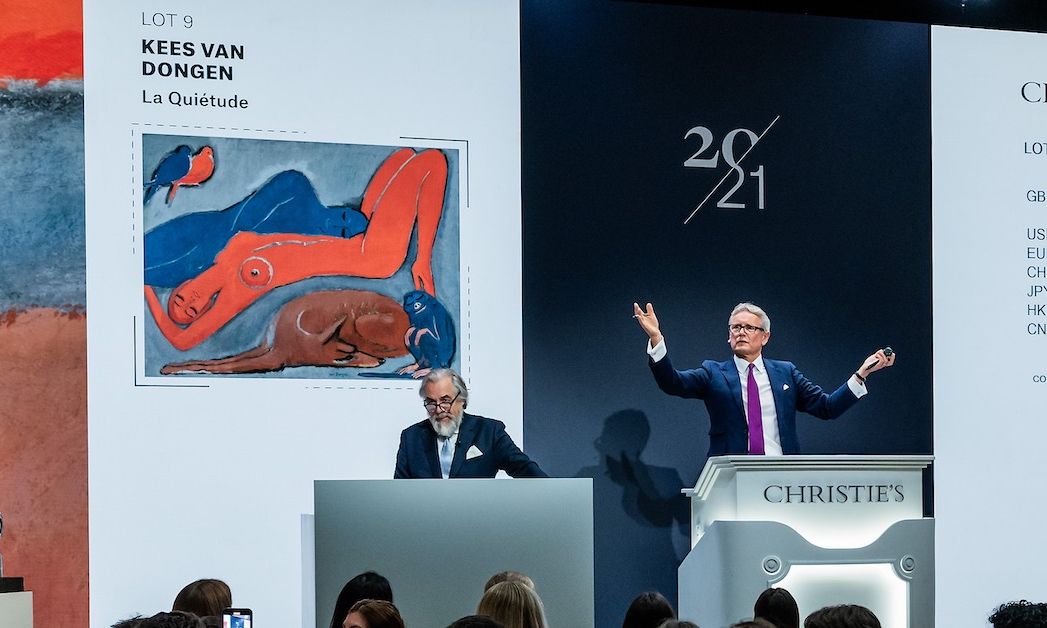Bidders compete for what proved to be the evening's top lot, La Quiétude (1918) by Kees van Dongen from the collection of Sam Josefowitz, at Christie's London on 13 October 2023 Courtesy Christie's Images Ltd.
Friday the 13th superstitions aside, Christie’s London still brought in £78.7m (£96.5m with fees) on Friday (13 October) across two evening sales, though bidding felt noticeably more controlled compared to auctions just within the past two years. The night kicked off with the house’s marquee auction of 20th century and 21st century art, which brought in a total of £36.4m (£44.6m with fees), well within the auction house’s £39.4m and £56.3m estimate range.
The liveliest lot of the sale was undoubtedly mononymous Italian painter Salvo’s ll giorno fu pieno di lampi la sera verranno le stelle (1991). Christie’s president Jussi Pylkkänen, who manned the rostrum for the first half of the sale, said 22 clients had registered to bid on the painting by telephone, the most he’d seen in his decades-long career. As bids came in every few seconds, Pylkkänen joked, “Who needs an auctioneer?” The painting sold for £550,000 (£693,000 with fees) against an £80,000 to £120,000 estimate, setting a new auction record for the artist.
Salvo, Il giorno fu pieno di lampi la sera verranno le stelle (The day was full of lightning in the evening stars will come out), 1991 Courtesy Christie's Images Ltd.
The room buzzed when a 1986 self-portrait of Lucian Freud came up for sale. The painting, which Christie’s said had never been publicly displayed before the sale, sold for £550,000 (£693,000 with fees) against a £300,000 to £500,000 estimate. Andy Warhol’s early Golden Nude (1957) fetched £245,000 (£308,700 with fees), significantly more than its £150,000 high estimate. The sale of Paula Rego’s Dancing Ostriches from Walt Disney's 'Fantasia’ (1995) for £2.5(£3m with fees) marked an auction record for the late artist.
Participation also picked up for Ewa Juszkiewicz’s Pukle (Locks) (2012), which sold for £280,00 (£352,800 with fees) against a £180,000 to £250,000 estimate. Another sought-after lot was the painting Hannah’s bathroom (2018) by Louis Frantino, which sold for £220,000 (£277,200 with fees) nearly five times the high end of its estimate. A second work by Fratino in the sale, the terracotta sculpture Couple (2019), exceeded expectations when it fetched £44,100 with fees.
Louis Fratino, Hannah's bathroom, 2018 Courtesy Christie's Images Ltd.
Still, bidding was largely conservative, and few lots exceeded their estimates without the auction house’s premiums and fees. The lot with the highest estimate in either of the evening’s sales was Jean-Michel Basquiat’s Future Sciences Versus the Man (1982), but bidding only lasted for two minutes before it hammered at £8.8m (£10.4 with fees), just shy of its £9m low estimate. Despite the unveiling of a massive installation by El Anatsui at the Tate Modern this week to rave reviews, the artist’s work Warrior (2015) fetched £650,000 (£819,000 with fees), coming in below Christie’s low estimate of £700,000 for the bottle-top sculpture. Several works by household names even failed to sell, including Flame (1992) by Yayoi Kusama and Warhol’s Diamond Dust Shoes (1980)—a more high-contrast canvas from the same Warhol series sold the night before at Sotheby’s for £3.3m (with fees).
Collectors seemed more willing to drop money during the second sale of the night, a stand-alone auction dedicated to the collection of mail-order businessman Sam Josefowitz (1921-2015), which fetched a collective £42.3m (£51.8 with fees), exceeding the high end of Christie’s estimate range by nearly £3m.
Aristide Maillol, Portrait de Mademoiselle Jeanne Faraill, 1888-89 Courtesy Christie's Images Ltd.
A significant number of works far surpassed their estimates, starting with the first lot of the sale, Aristide Maillol’s Portrait de Mademoiselle Jeanne Faraill (1888-89), which sold for £1.95m (nearly £2.4m with fees), almost double the high end of its estimate and setting a record for the artist at auction. The second Josefowitz lot, a Rembrandt self-portrait etching, realised £220,000 (£277,000 with fees). The etching had been expected to fetch between £80,000 and £120,000. Pylkkänen noted the result would bode favourably for the remainder of Josefowitz’s collection of Rembrandt prints, which are scheduled to come to auction at Christie’s London in December. The sale also set a new auction record for Félix Vallotton, whose painting Cinq Heures (1898) sold for £3.6m (including fees).
Josefowitz had a wide and varied collection, ranging from canonic modern art and design to antiquities from Asia and the Middle East. A large Thai bronze of Buddha dated to around the 15th century sold for £480,000 (£604,800 with fees), and an Assyrian relief from around the ninth century BCE sold for £3.2m (£3.9m with fees). A carved figure of the Hindu deity Ganesha from around the 11th century failed to sell.
Kees van Dongen, La Quiétude, 1918 Courtesy Christie's Images Ltd.
The highlight of the Josefowitz sale may have been Dutch-French artist Kees Van Dongen’s La Quiétude (1918). Two determined, steady bidders drove the final price all the way up to £9.1m (£10.8m with fees), causing the room to break out in applause for the most valuable lot of the evening. After the sale of the Van Dongen painting, the King Street saleroom began to empty out.
Another surprising moment of the Josefowitz auction was the flop of a rare Paul Gauguin portrait, Clovis endormi (1884) by. After bidding stalled at £2.4m, short of Christie’s £3m low estimate, Pylkkänen passed the lot. The painting, which depicts Gauguin’s son Clovis, has been on loan to the Art Gallery of Ontario in Toronto since 2008. Another painting by Van Dongen, La Porte Dauphine (1923), also failed to sell.
According to Christie’s, the two sales were expected to bring in between £70.8m and £106.3m collectively. The £96.5m figure means the auction house landed near the high end of their expectations, with the sales having a combined 85% sell-through rate. For comparison’s sake Sotheby’s, whose double-header of Frieze Week evening auctions on 12 October featured significantly fewer lots, brought in just £45.6m (with fees) in total.

